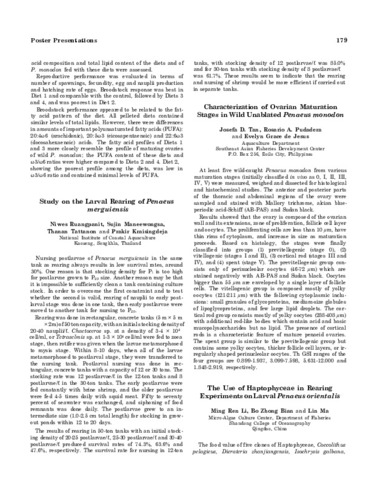Study on the larval rearing of Penaeus merguiensis
- Global styles
- MLA
- Vancouver
- Elsevier - Harvard
- APA
- Help
Share
Abstract
Nursing postlarvae of Penaeus merguiensis in the same tank as rearing always results in low survival rates, around 30%. One reason is that stocking density for P1 is too high for postlarvae grown to P20 size. Another reason may be that it is impossible to sufficiently clean a tank containing culture stock. In order to overcome the first constraint and to test whether the second is valid, rearing of nauplii to early postlarval stage was done in one tank, then early postlarvae were moved to another tank for nursing to P20.
Rearing was done in rectangular, concrete tanks (5 m × 5 m × 2m) of 50 ton capacity, with an initial stocking density of 20-40 nauplii/ℓ. Chaetoceros sp. at a density of 3-4 × 104 cell/ml, or Tetraselmis sp. at 1-3 × 104 cell/ml were fed to zoea stage, then rotifer was given when the larvae metamorphosed to mysis stage. Within 8-10 days, when all of the larvae metamorphosed to postlarval stage, they were transferred to the nursing tank. Postlarval nursing was done in rectangular, concrete tanks with a capacity of 12 or 30 tons. The stocking rate was 12 postlarvae/ℓ in the 12-ton tanks and 8 postlarvae/ℓ in the 30-ton tanks. The early postlarvae were fed constantly with brine shrimp, and the older postlarvae were fed 4-5 times daily with squid meat. Fifty to seventy percent of seawater was exchanged, and siphoning of food remnants was done daily. The postlarvae grew to an intermediate size (1.0-2.5 cm total length) for stocking in grow-out ponds within 12 to 20 days.
The results of rearing in 50-ton tanks with an initial stocking density of 20-25 postlarvae/ℓ, 25-30 postlarvae/ℓ and 30-40 postlarvae/ℓ produced survival rates of 74.3%, 63.6% and 47.6%, respectively. The survival rate for nursing in 12-ton tanks, with stocking density of 12 postlarvae/ℓ was 85.0% and for 30-ton tanks with stocking density of 8 postlarvae/ℓ was 61.7%. These results seem to indicate that the rearing and nursing of shrimp would be more efficient if carried out in separate tanks.
Description
Abstract only.
Suggested Citation
Ruangpanit, N., Maneewongsa, S., Tattanon, T., & Kraisingdeja P. (1985). Study on the larval rearing of Penaeus merguiensis (Abstract only). In Taki Y., Primavera J.H. and Llobrera J.A. (Eds.). Proceedings of the First International Conference on the Culture of Penaeid Prawns/Shrimps, 4-7 December 1984, Iloilo City, Philippines (p. 179). Iloilo City, Philippines: Aquaculture Department, Southeast Asian Fisheries Development Center.
Type
Conference posterISBN
9718511008



